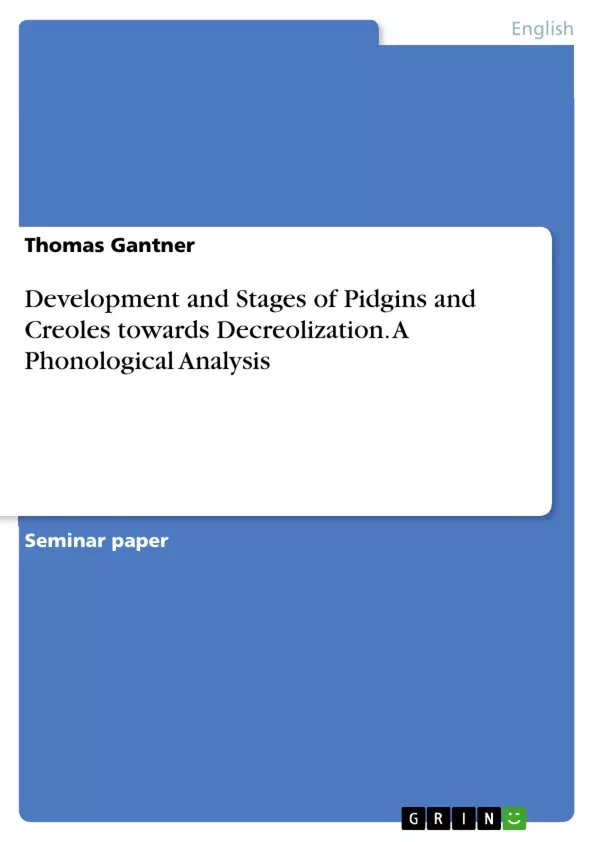First, I will briefly portray the emergence of pidgin and creole languages and their development towards the post-creole continuum. I will examine the different types of pidgin-creole developments and the phenomenon of decreolizing - the approximation of the creole towards the lexifier by using the example of the Hawaiian Creole that I will also portray out of a socio-historical point of view. That creole is officially still called ‘Hawai’i Pidgin’ by its speakers, but I will avoid using that term in my paper.
Therefore, the term Hawai’i Creole English, short HCE, is more appropriate. Furthermore, I will deal with HCE’s phonology, especially with its difference to Standard English, in detail – due to the question whether HCE is decreolizing or not. As Norval S. H. Smith states, creole phonology is a “neglected field” and “younger languages” have the tendency to be not as much irregular as “elder language” tend to be.
Table of Contents
- Introduction
- Development and emergence of Pidgins and Creoles by using the example of Hawai'i Pidgin English
- Emergence of Pidgin and Creole languages
- A brief socio-historical overview of pidgin
- Stages in the development of a pidgin towards a creole
- Further Development: Decreolization
- Grammatical Features of Hawai'i Pidgin English
- Phonology of Hawai'i Pidgin English with textual proof
- Vowels in Hawai'i Pidgin English
- Consonants in Hawai'i Pidgin
- Phonology of Hawai'i Pidgin English with textual proof
- Conclusion
Objectives and Key Themes
This research paper aims to explore the development of Hawai'i Pidgin English within the framework of the post-creole continuum. It examines the emergence and evolution of pidgins and creoles, focusing on the socio-historical context of Hawai'i Pidgin English. The paper investigates the process of decreolization, comparing the phonology of Hawai'i Pidgin English to Standard English to assess its ongoing development.
- Emergence and development of pidgins and creoles
- Socio-historical overview of Hawai'i Pidgin English
- Decreolization and its impact on Hawai'i Pidgin English
- Phonological features of Hawai'i Pidgin English
- Comparison of Hawai'i Pidgin English to Standard English
Chapter Summaries
- Introduction: This chapter introduces the research topic by using a poem from the Pidgin Bible from Hawai'i, highlighting the influence of Standard English on the development of Hawai'i Pidgin English. The chapter outlines the objectives and scope of the paper, focusing on the emergence, development, and decreolization of Hawai'i Pidgin English.
- Development and emergence of Pidgins and Creoles: This chapter examines the origins and development of pidgin and creole languages. It discusses the factors leading to their emergence, the role of the lexifier and substrate languages, and the gradual transition from a pidgin to a creole. The chapter illustrates these concepts using the example of Hawai'i Pidgin English.
- A brief socio-historical overview of pidgin: This chapter provides a historical context for the development of Hawai'i Pidgin English, tracing its evolution from the arrival of Europeans in the 18th century through the establishment of sugarcane plantations in the 19th century. It discusses the influence of various ethnical groups and the emergence of Pacific and Chinese Pidgin English in Hawai'i.
- Stages in the development of a pidgin towards a creole: This chapter explores the different stages involved in the development of a pidgin towards a creole. It examines the factors that contribute to the stabilization of a pidgin, the role of nativization, and the expansion of morphosyntactic structures in creoles. The chapter also discusses the concept of "abrupt creolization," where a creole emerges rapidly without a clear preceding pidgin stage.
- Further Development: Decreolization: This chapter investigates the phenomenon of decreolization, where a creole language gradually approximates its lexifier language. The chapter explores the processes involved in decreolization and its implications for the future development of Hawai'i Pidgin English.
- Grammatical Features of Hawai'i Pidgin English: This chapter focuses on the grammatical features of Hawai'i Pidgin English, specifically its phonology. It examines the differences between Hawai'i Pidgin English and Standard English in terms of vowel and consonant sounds, providing textual proof for the analysis.
Keywords
The research paper explores key terms and concepts related to pidgin and creole linguistics, specifically focusing on Hawai'i Pidgin English. The main keywords include: pidgin, creole, post-creole continuum, decreolization, lexifier, substrate, socio-historical context, phonology, Hawai'i Pidgin English, Standard English.
- Quote paper
- Thomas Gantner (Author), 2011, Development and Stages of Pidgins and Creoles towards Decreolization. A Phonological Analysis, Munich, GRIN Verlag, https://www.grin.com/document/300313



